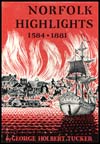Chapter 30
The Chesapeake-Leopard Affair
The prelude and epilogue of the Chesapeake-Leopard affair that came close to causing hostilities between the United States and Great Britain took place in Norfolk.
On June 22, 1807, the United States frigate Chesapeake cleared Norfolk area waters for the Mediterranean to relieve the USS Constitution as flagship of the European station. In command was Captain (later Commodore) James Barron, who had been the senior officer aboard for only one day.
The Chesapeake was badly prepared for her mission. Her crew was shorthanded and untrained, her decks were littered with unstowed gear, and her powder flasks and loggerheads were stored away in her hold.
Standing down Thimble Shoals Channel, the Chesapeake passed a British squadron anchored in Lynnhaven Roads. Catching sight of the Chesapeake, one of the British vessels, the HMS Leopard, weighed anchor and followed her.
Side by side the two ships sailed to about forty miles at sea, at which point the Leopard passed the Chesapeake, then backed a topsail and waited until the Chesapeake came down to her. At that point a British lieutenant was rowed over to the Chesapeake in a small boat. When he came aboard and was taken to Captain Barron, he informed the latter that his ship would have to submit to a search for supposed deserters from the Royal Navy who were believed to be on board. Barron naturally refused to comply, and the British lieutenant was rowed back to the Leopard.
Seeing that the Leopard's gunports were open and her guns were run out, Barron and his officers made a frantic effort to prepare the Chesapeake for resistance, but they were hindered by the unprepared condition of the vessel's armament. The Leopard then blazed away at the Chesapeake for fifteen minutes, killing three men and wounding eighteen before Barron struck his colors. The British lieutenant then returned to Barron's riddled ship and took out three men whom the British claimed were deserters, plus a fourth man for good measure.
When the news of the incident filtered back into Norfolk, enraged citizens swarmed out in rowboats to every vessel which came in from the Virginia Capes to question their crews and passengers. Finally, when they saw a vessel approaching carrying eleven wounded men from the Chesapeake, all doubts were dispelled.
Seeking immediate revenge, Norfolk citizens held a mass meeting at which it was unanimously agreed to refuse all intercourse with any of the British men of war in the area, either by providing them with pilots or by selling them supplies or water. In the meantime, a subscription was gotten up for the families of the men who had been killed by Leopard's guns.
On June 27, 1807, when Robert MacDonald, one of the wounded Chesapeake sailors, died in the Marine Hospital at Washington Point, later known as Berkley, his funeral in Norfolk became the occasion of a great public demonstration.
As his body was ferried across the river to the County Wharf, all of the American vessels in the harbor displayed their colors at half mast, while minute guns were fired by the artillery on shore. An estimated four thousand citizens were waiting on Market Square, and while the coffin was being landed, they formed themselves into a long procession.
The cortege was made up of the coffin accompanied by masters of vessels in the harbor who had been selected as pallbearers, borough officials and military companies, and captains, mates, and seamen from other vessels. These and the long line of citizens then marched to the measure of muffled drums to the first Christ Church on Church Street for an elaborate funeral service in MacDonald's honor.
Chapter
31
Historic Fort Norfolk
Norfolk Highlights 1584 - 1881

See the "Table of Contents" for links to every chapter in Norfolk Highlights 1584 - 1881 by George Holbert Tucker.
